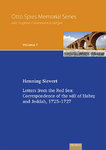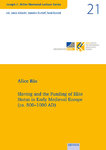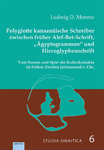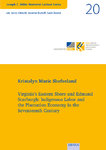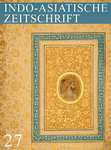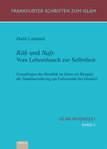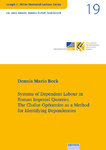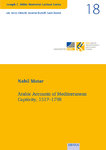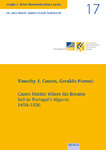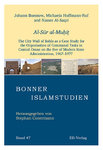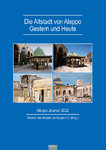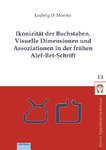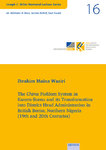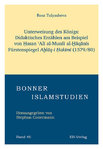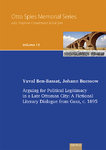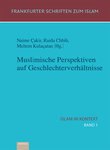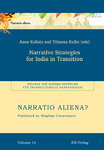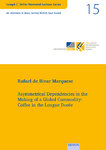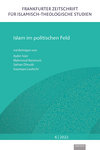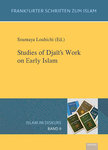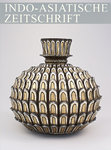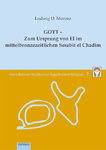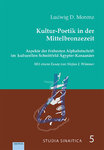Verlag für Wissenschaft und Praxis
Categories ISLAMWISSENSCHAFT Reihe: Ulrich Haarmann Memorial Lecture Volume 11: The Battle of ʿAyn Jālūt: A Paradigmatic Historical Event in Mamlūk Historical Narrative
Categories ISLAMWISSENSCHAFT Reihe: Ulrich Haarmann Memorial Lecture Volume 12: Numismatic Nights: Gold, Silver, and Copper Coins in the Mahdi
Categories ISLAMWISSENSCHAFT Reihe: Ulrich Haarmann Memorial Lecture Volume 13: A King of the Two Seas?
Categories ISLAMWISSENSCHAFT Reihe: Ulrich Haarmann Memorial Lecture Volume: 14: Date Palm Production in Rasulid Yemen
Categories ISLAMWISSENSCHAFT Reihe: Ulrich Haarmann Memorial Lecture Volume 15: Jordan as an Ottoman Frontier Zone in the Sixteenth-Eighteenth Centuries
Categories ISLAMWISSENSCHAFT Reihe: Ulrich Haarmann Memorial Lecture Volume 16: Conceptualizing Frankish-Muslim Partition Truces in the Coastal Plain and Greater Syria
Categories ISLAMWISSENSCHAFT Reihe: Ulrich Haarmann Memorial Lecture Volume 17: The Waqf of a Physician in Late Mamluk Damascus and its Fate under the Ottomans
Categories ISLAMWISSENSCHAFT Reihe: Ulrich Haarmann Memorial Lecture Volume 18: Ibn Khaldūn versus the occultists at Barqūq’s court:
Categories ISLAMWISSENSCHAFT Reihe: Ulrich Haarmann Memorial Lecture Volume 19: From Turks to Mongols: David Ayalon’s Vision of the Eurasian Steppe in Islamic History
Categories ISLAMWISSENSCHAFT Reihe: Ulrich Haarmann Memorial Lecture Volume 20: Custodians of the Holy Sanctuaries: Rasulid-Mamluk Rivalry in Mecca
Volume 11: The Battle of ʿAyn Jālūt: A Paradigmatic Historical Event in Mamlūk Historical Narrative
Artikel-Nr.: ISBN 978-3-86893-160-0
Auf Lager
innerhalb 3 Tagen lieferbar
Preis inkl. MwSt.
Kunden, die dieses Produkt gekauft haben, haben auch diese Produkte gekauft
|
|
|
|
|
|
|
Diese Kategorie durchsuchen: Reihe: Ulrich Haarmann Memorial Lecture
Volume 12: Numismatic Nights: Gold, Silver, and Copper Coins in the Mahdi
Artikel-Nr.: ISBN 978-3-86893-179-2
Auf Lager
innerhalb 3 Tagen lieferbar
Preis inkl. MwSt.
Kunden, die dieses Produkt gekauft haben, haben auch diese Produkte gekauft
|
Volume 11: The Battle of ʿAyn Jālūt: A Paradigmatic Historical Event in Mamlūk Historical Narrative
7,00 €
*
|
|
|
|
|
|
Diese Kategorie durchsuchen: Reihe: Ulrich Haarmann Memorial Lecture
Volume 13: A King of the Two Seas?
Artikel-Nr.: ISBN 978-3-86893-223-2
Auf Lager
innerhalb 3 Tagen lieferbar
Preis inkl. MwSt.
Kunden, die dieses Produkt gekauft haben, haben auch diese Produkte gekauft
|
|
|
|
|
|
|
Diese Kategorie durchsuchen: Reihe: Ulrich Haarmann Memorial Lecture
Volume: 14: Date Palm Production in Rasulid Yemen
Artikel-Nr.: ISBN 978-3-86893-227-0
Auf Lager
innerhalb 3 Tagen lieferbar
Preis inkl. MwSt.
Kunden, die dieses Produkt gekauft haben, haben auch diese Produkte gekauft
|
|
|
Volume 16: Conceptualizing Frankish-Muslim Partition Truces in the Coastal Plain and Greater Syria
9,90 €
*
|
|
|
|
Diese Kategorie durchsuchen: Reihe: Ulrich Haarmann Memorial Lecture
Volume 15: Jordan as an Ottoman Frontier Zone in the Sixteenth-Eighteenth Centuries
Artikel-Nr.: ISBN 978 -3-86893 -276-8
Auf Lager
innerhalb 3 Tagen lieferbar
Preis inkl. MwSt.
Kunden, die dieses Produkt gekauft haben, haben auch diese Produkte gekauft
|
|
|
|
|
|
Volume 16: Conceptualizing Frankish-Muslim Partition Truces in the Coastal Plain and Greater Syria
9,90 €
*
|
Diese Kategorie durchsuchen: Reihe: Ulrich Haarmann Memorial Lecture
Volume 16: Conceptualizing Frankish-Muslim Partition Truces in the Coastal Plain and Greater Syria
Artikel-Nr.: ISBN: 978-3-86893-288-1
Auf Lager
innerhalb 3 Tagen lieferbar
Preis inkl. MwSt.
Kunden, die dieses Produkt gekauft haben, haben auch diese Produkte gekauft
|
|
|
|
|
|
|
Diese Kategorie durchsuchen: Reihe: Ulrich Haarmann Memorial Lecture
Volume 17: The Waqf of a Physician in Late Mamluk Damascus and its Fate under the Ottomans
Artikel-Nr.: ISBN: 978-3-86893-289-8
Auf Lager
innerhalb 3 Tagen lieferbar
Preis inkl. MwSt.
Kunden, die dieses Produkt gekauft haben, haben auch diese Produkte gekauft
|
|
|
|
|
Volume 16: Conceptualizing Frankish-Muslim Partition Truces in the Coastal Plain and Greater Syria
9,90 €
*
|
|
Diese Kategorie durchsuchen: Reihe: Ulrich Haarmann Memorial Lecture
Volume 18: Ibn Khaldūn versus the occultists at Barqūq’s court:
Artikel-Nr.: ISBN 978-3-86893-290-4
Auf Lager
innerhalb 3 Tagen lieferbar
Preis inkl. MwSt.
Kunden, die dieses Produkt gekauft haben, haben auch diese Produkte gekauft
|
|
|
|
|
|
|
Diese Kategorie durchsuchen: Reihe: Ulrich Haarmann Memorial Lecture
Volume 19: From Turks to Mongols: David Ayalon’s Vision of the Eurasian Steppe in Islamic History
Artikel-Nr.: ISBN: 978-3-86893-291-1
Auf Lager
innerhalb 3 Tagen lieferbar
Preis inkl. MwSt.
Kunden, die dieses Produkt gekauft haben, haben auch diese Produkte gekauft
|
|
|
Volume 16: Conceptualizing Frankish-Muslim Partition Truces in the Coastal Plain and Greater Syria
9,90 €
*
|
|
|
|
Diese Kategorie durchsuchen: Reihe: Ulrich Haarmann Memorial Lecture
Volume 20: Custodians of the Holy Sanctuaries: Rasulid-Mamluk Rivalry in Mecca
Artikel-Nr.: ISBN: 978-3-86893-311-6
Auf Lager
innerhalb 3 Tagen lieferbar
Preis inkl. MwSt.
Kunden, die dieses Produkt gekauft haben, haben auch diese Produkte gekauft
|
|
|
|
|
|
|
Diese Kategorie durchsuchen: Reihe: Ulrich Haarmann Memorial Lecture




